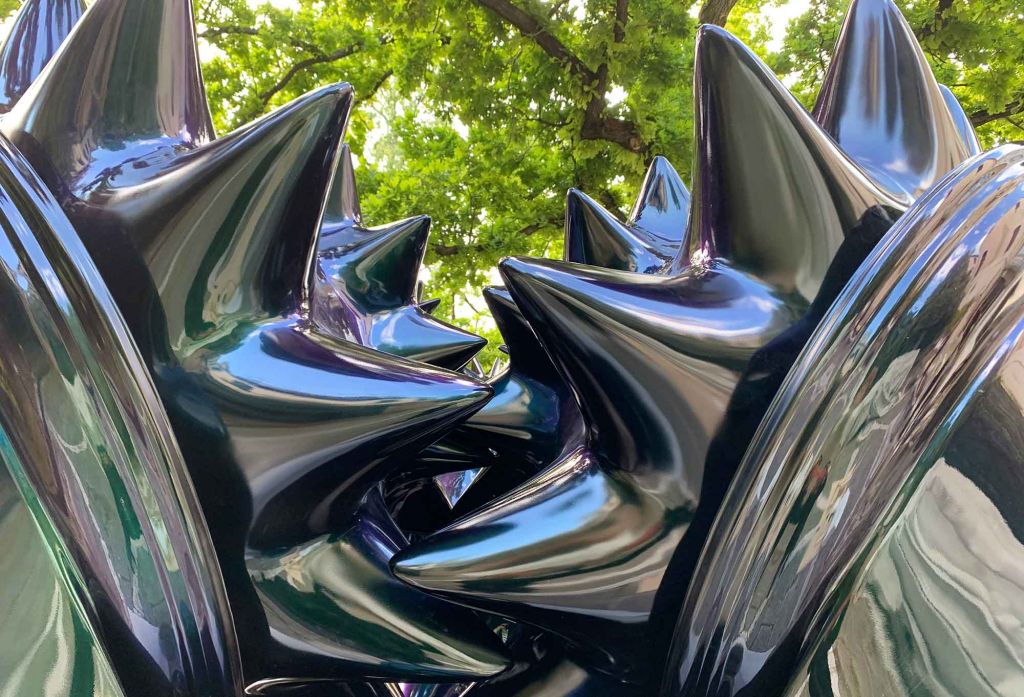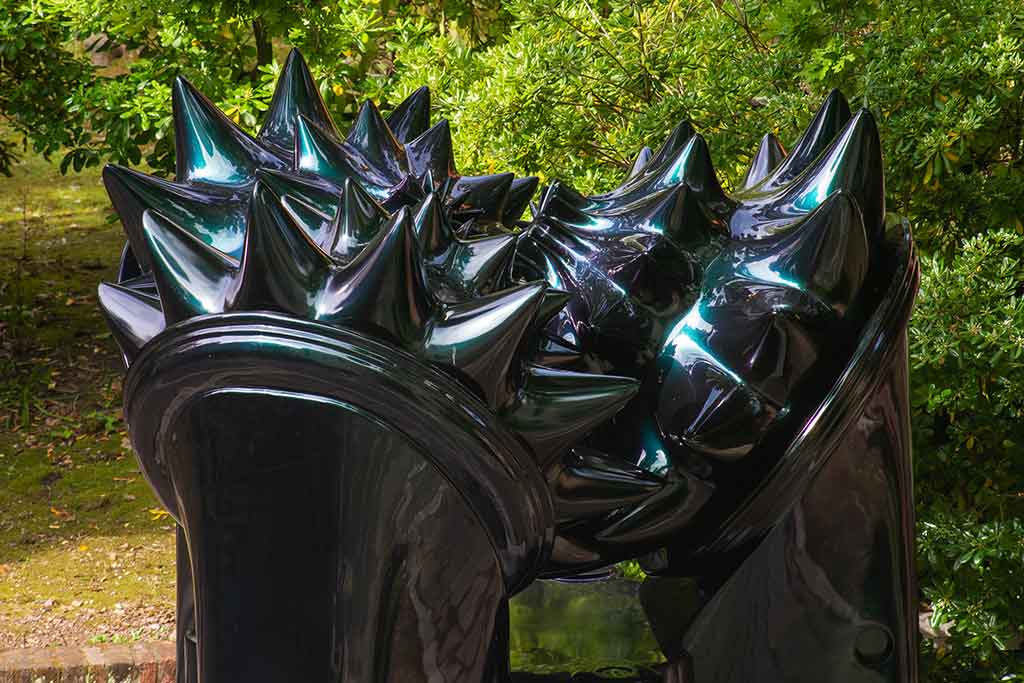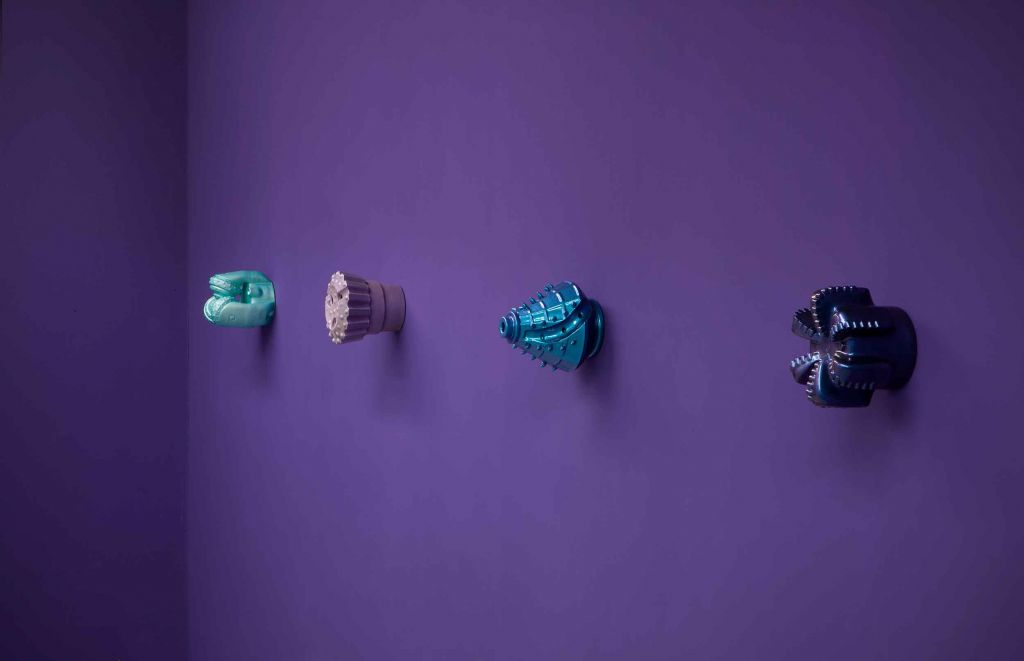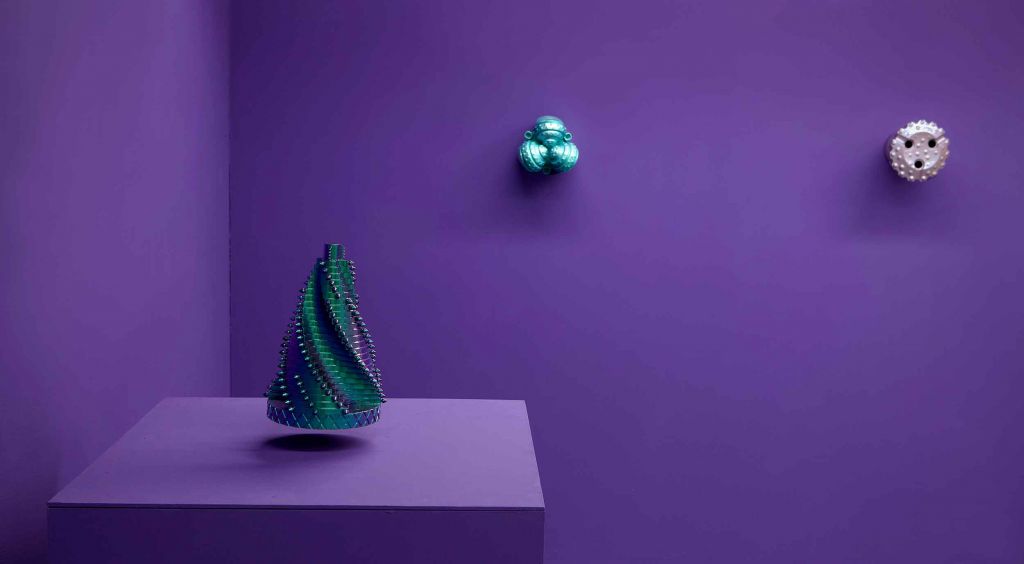Interview by Leoni Fischer

In the early 1950s, when the business with the ‘black gold’ took off at an enormous pace, the Arab states of the Persian Gulf became leading in the export of oil. Raised in Kuwait as a child of the post-oil generation, Berlin-based visual artist Monira Al Qadiri grew up in a society that had been fundamentally changed through the rise of this new economy, which quickly accumulated enormous wealth. Ambitious urban development projects, new modes of labour and the violence of the Gulf War are just some aspects of this world shaped by oil the artist refers to in her works which she considers part of her artistic self-portrait.
Alien Technology (2014-2019) is the name of a series of large-scale public monuments, one of which was recently exhibited at the artist’s solo show Holy Quarter at Haus der Kunst in Munich. The oversize fibreglass drill head with its dichroic permute resembling patina shimmers seductively. At the same time, the body’s mere mass and animate rotation ends convey the atmosphere of a dark, uncanny power – the triumph of the oil. While Monira Al Qadiri’s occupation with the theme of ‘Petroculture’ may derive from her personal background, her works speak to an audience that consequently must be as global as the distribution of petroleum and its products.
For instance, looking at the work through the lens of Christian theology, the famous story from the Old Testament, The dance around the golden calf comes to mind, which is commonly considered to be the first violation of the prohibition against idolatry. Often violently misread and abused by antisemite conspiracy theorists, the metaphor of worshipping the golden calf here becomes relevant in relation to the fleeting wealth generated through the extraction of fossil fuels.
Sedimenting through all layers of everyday life by providing consumer goods or mobility, oil is fueling our convenient capitalist lifestyles. And even though the oil age will eventually only be a ‘freak interval’ in world history, its products will surely outlive us. Maybe the aura of Al Qadiri’s works reveals our constant underlying fear of the end of petroleum and the ecological damage caused by its extraction – a pressing challenge many policymakers around the world seem to displace effectively.
For me, what makes Al Qadiri’s works so captivating is the fluent meandering of different meanings inside them. Semiotician, novelist and philosopher Umberto Eco famously described this perceptive quality as the element of multiplicity and plurality in a piece of art. The shimmering patina of Al Qadiri’s pieces not only seems to create an endless loop of inward multiplication but simultaneously displays and distorts the work’s spatial context.
Differing from Alien Technology in terms of presentation and size, the work Spectrum (2016) can serve as an example of the illusionist temptation Al Qadiri’s works excerpt. The precise models of different drill heads lined up along the wall, shimmering in dichroic colours, mesmerisingly lure the mind into transforming these technological tools into secretive relics of alien sea creatures or rare pearls. The viewer’s imagination constantly travels between the functional reality of the models and their mystical aura.
Even though their shapes explicitly serve technological purposes, the illusory shiny surface of the objects appears extremely organic. Like the first individual of a newly discovered butterfly-species brought back from the field-work and pinned down inside one of those sterile white-padded preservation crates, the artworks emit the fleeting but independent aura of something unnamed, unclassified, alien but strangely familiar.
Monira Al Qadiri’s art tells the tragic fictional tale we all inhabit. Almost like future memorials, her works point towards the determined end of the ‘oil age’ and make us speculate about what will remain of its culture in the future.




In your practice, you are working with different media, such as film and sculpture, to address questions of the post-oil generation. For our audience that is not familiar with your work, could you tell us a bit about your background, interests and inspirations?
I grew up in Kuwait, which is a country that is almost entirely dependent on income from oil revenues. And so the question of oil itself becomes an existential one: how do we survive without it? What does the future look like once the economy collapses completely? It’s a finite resource that’s doomed to fail, so through my work, I am always trying to tackle questions around this inevitable destiny.
You recently showed your multi-part sculpture and film Holy Quarter at Haus der Kunst, Munich. What got you interested in the Empty Quarter desert region, and what did the process of developing this complex work look like?
I have always been fascinated by the relationship between meteorites and the desert ever since my father brought one back with him from the Empty Quarter when I was younger. I decided to develop a workaround for this subject while also linking it to historic and pre-historic ideas in the Gulf region, all the while reflecting on concepts around outer space and a post-apocalyptic future.
Your grandfather used to work as a singer on a pearling boat. In the performance DIVER, four dancers move through the water to a traditional pearl diving song. Could you tell us more about this (lost) tradition? What does it mean to you?
Pearl diving was the main industry in the coastal Gulf region for hundreds of years before the discovery of oil. As someone who is part of the post-oil generation, I feel like that tradition of diving for pearls in the ocean sounds almost like a fairy tale. For the longest time, I felt like my grandfather’s life as a singer was some kind of fiction. So I wanted to create links between him and me using colour and form, to highlight the huge rupture in the history caused by oil. DIVER is an amalgamation of all of these ideas into one video work.
Petroculture – the culture that evolved with the oil extraction in the Gulf region – and its relics are a recurring motive in your art. Today oil resources are shrinking rapidly, and no one knows exactly when ‘Peak Oil’ will be reached or if we have reached it already. Will the end of oil be the end of Petroculture, and how do you think this transition will become visible through the arts?
Yes, I believe the end of oil will spell the end of Petro-culture. Although oil has wide uses beyond being just a fuel source, we have seen already during the pandemic what happens when demand drops – the price goes to minus because of overproduction. I think the oil interval in history is a ‘freak’ interval that will not last very long. The culture that has mutated and formed around it will inevitably change and transform into something else, leaving remnants and ruins in its wake.
In another interview, you stated that making art helps you to reflect on earlier stages of your life. For most people, contemplating our past usually stays merely a mental process. When did you start reflecting through physical, creative making, and how do you think this mode has formed the person you are today?
My work revolves around tragic subjects and characters that can modulate between the past, present and future. This mental time travel is very important to me, as art has the capacity to survive for an unspecified amount of time, changing its meaning and perception quite dramatically. That’s why I think it is important not only to focus on the contemporary moment but to have a longer arc of time present in the work.
Some of your pieces appear almost like personal keepsakes, while in a few cases, like Alien Technology, an object presents itself in the gigantic shape of a public monument. What role do the interrelations of private and public, individual and collective, play in your work?
For me making art in public space is an integral part of my practice. The public realm is so much more expansive and interesting than a closed space that only a select few will enter and see, but it’s also much more precarious and chaotic. So that doesn’t negate works that are more delicate in nature and require close viewing. I guess it depends on each work and the specific universe that that piece creates around itself.
What’s your chief enemy of creativity?
Food.
You couldn’t live without…
Melancholy.






